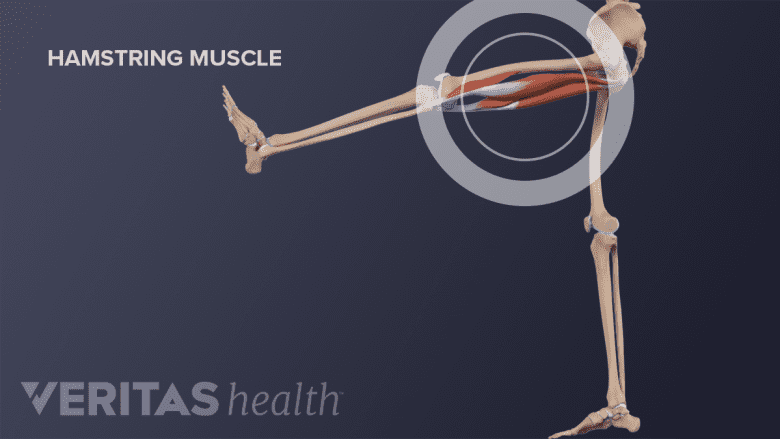Many younger and active people experience IT band pain at one point or another. The condition typically occurs after a change in workout routine. Either workouts have ramped up too quickly or exercise form or equipment has changed.

Tightness in the hamstrings or other thigh muscles can lead to tightness in the IT band.
In This Article:
- Iliotibial Band Syndrome
- IT Band Syndrome Symptoms
- IT Band Syndrome Causes and Risk Factors
- IT Band Syndrome Diagnosis
- IT Band Syndrome Treatment
Mistakes in Training That Affect the IT Band
Below are descriptions of common training mistakes that can lead to IT band friction.
Lack of strength or flexibility. If the muscles at the inside of the thigh, called hip adductors, are weak, then the IT band can become tight. Similarly, if the hamstrings or other thigh muscles are too tight the IT band may also become tight.
Dropping the hips. Ideally, the hips stay level with each running stride. Dropping the hips is a sign of outward (abduction) or inward (adduction) hip movement, which puts the IT band at higher risk for strain.1Noehren B, Davis I, Hamill J. ASB clinical biomechanics award winner 2006 prospective study of the biomechanical factors associated with iliotibial band syndrome. Clin Biomech (Bristol, Avon). 2007;22(9):951-956. doi: 10.1016/j.clinbiomech.2007.07.001,2Mohammad WS, Elsais WM. Association Between Hip Rotation and Activation of the Quadriceps and Gluteus Maximus in Male Runners. Orthop J Sports Med. 2020;8(11):2325967120962802. doi:10.1177/2325967120962802
Rotating the knee inward. During a running stride, the knee of the front leg might move both forward and inward, toward the centerline of the body. Doctors call this inward movement internal knee rotation, and it puts extra strain on the IT band.1Noehren B, Davis I, Hamill J. ASB clinical biomechanics award winner 2006 prospective study of the biomechanical factors associated with iliotibial band syndrome. Clin Biomech (Bristol, Avon). 2007;22(9):951-956. doi: 10.1016/j.clinbiomech.2007.07.001,2Mohammad WS, Elsais WM. Association Between Hip Rotation and Activation of the Quadriceps and Gluteus Maximus in Male Runners. Orthop J Sports Med. 2020;8(11):2325967120962802. doi:10.1177/2325967120962802
Dropping the hips or rotating the knees inward is often linked to issues with muscle strength. For example, the thigh’s quadriceps muscles might be much stronger relative to the hip’s gluteus muscles, causing the thigh to turn inward.1Noehren B, Davis I, Hamill J. ASB clinical biomechanics award winner 2006 prospective study of the biomechanical factors associated with iliotibial band syndrome. Clin Biomech (Bristol, Avon). 2007;22(9):951-956. doi: 10.1016/j.clinbiomech.2007.07.001,2Mohammad WS, Elsais WM. Association Between Hip Rotation and Activation of the Quadriceps and Gluteus Maximus in Male Runners. Orthop J Sports Med. 2020;8(11):2325967120962802. doi:10.1177/2325967120962802
Skipping warm-up exercises. While it is tempting to jump right into a workout, muscles and soft tissue will benefit from 5 or 10 minutes of warm-up exercise before building up to more intense activity.
Ramping up training too fast. An ambitious training schedule is not always good for joints. To avoid IT band syndrome and other injuries, athletes are advised to slowly add to the length and intensity of their workouts over several weeks or months.
Wearing the wrong footwear. How the foot lands on the ground affects not just joints in the foot and ankle, but also the knee and hip, including the muscles and other soft tissue that support those joints. Good footwear can improve biomechanics and reduce or prevent IT band pain.
Running on hard or uneven surfaces. Runners increase their risk of getting IT band syndrome by running on a surface or terrain that is:
- Too hard, such as concrete sidewalks
- Angled downhill3Hutchinson LA, Lichtwark GA, Willy RW, Kelly LA. The Iliotibial Band: A Complex Structure with Versatile Functions. Sports Med. 2022;52(5):995-1008. doi:10.1007/s40279-021-01634-3
- Uneven or banked, such as the side of the road, where it slants downward towards the curb
Cycling with poor form. Cyclists increase their risk of IT band friction syndrome if:
- The bike seat is too high, forcing the leg to extend too much, which can aggravate IT band problems
- Gears are set too high, forcing the leg to work harder at fewer RPMs
- The pedals and toe clips are not adjusted to suit the individual
While runners and cyclists are especially susceptible to IT band pain, it can affect any athlete who engages in repetitive knee motion. Speed-walkers, basketball players, soccer players, and weightlifters are other examples of athletes who may experience IT band syndrome.
Other Risk Factors
Training mistakes do not account for all the risk factors for iliotibial band syndrome. Some risk factors are fixed, meaning they cannot be changed. These risk factors include:
- Age. For adult men, younger age is also a risk factor.
- Sex. People assigned to female at birth are more likely to develop IT band syndrome.
- Joint problems. People who have bow legs or whose legs are slightly different lengths are predisposed to IT band syndrome.
Keep in mind, a person may have just one risk factor and develop IT band syndrome while another has nearly all these risk factors and never develops it. Each person has unique anatomy and health circumstances.
- 1 Noehren B, Davis I, Hamill J. ASB clinical biomechanics award winner 2006 prospective study of the biomechanical factors associated with iliotibial band syndrome. Clin Biomech (Bristol, Avon). 2007;22(9):951-956. doi: 10.1016/j.clinbiomech.2007.07.001
- 2 Mohammad WS, Elsais WM. Association Between Hip Rotation and Activation of the Quadriceps and Gluteus Maximus in Male Runners. Orthop J Sports Med. 2020;8(11):2325967120962802. doi:10.1177/2325967120962802
- 3 Hutchinson LA, Lichtwark GA, Willy RW, Kelly LA. The Iliotibial Band: A Complex Structure with Versatile Functions. Sports Med. 2022;52(5):995-1008. doi:10.1007/s40279-021-01634-3

